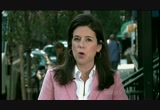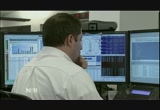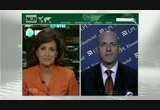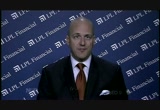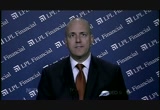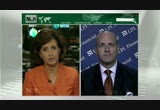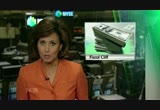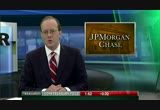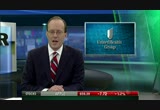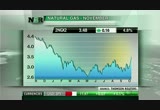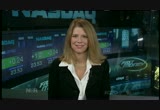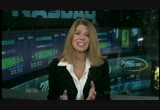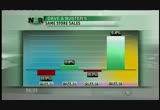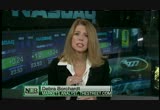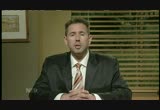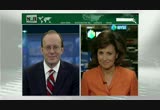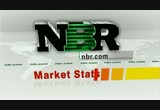tv Nightly Business Report PBS October 2, 2012 1:00am-1:30am PDT
1:00 am
>> this is n.b.r. >> susie: good evening everyone, i'm susie gharib. american factories were going all out in september, a hopeful sign that the u.s. economy may be picking up. >> tom: i'm tom hudson. ben bernanke defends his strategy at the federal reserve to do more to help the economy. >> susie: and how technology is making it possible for doctors to go paperless. >> tom: that and more tonight on "n.b.r."! >> susie: the first day of the new quarter, kicks off with a blue chip rally. investors were encouraged by a report showing that american factories were busy in september. a popular index of national factory activity rose to 51.5 last month, from 49.6 in august. it was the fastest pace of production since may. but that upbeat news was overshadowed by comments from federal reserve chief ben bernanke, saying the economy is not growing fast enough to bring
1:01 am
down the unemployment rate. we'll have more on that in a moment. those two events led to volatile trading here on wall street. the dow rose about 78 points, but was up as much as 155 points earlier. the nasdaq drifted in and out of positive and negative territory, finally losing more than 2.5 points, and the s&p rose almost four points. and, as suzanne pratt reports there are conflicting views on the state of american manufacturing. >> reporter: from cardboard boxmakers, to icemakers, to uniform manufacturers, factories across the u.s. are once again humming with activity. sure, the pace of production is slow but, there are some hopeful signs about the future. namely, the new orders index jumped to 52.3 in september from 47.1 in august. that suggests production will be humming this month and in november. in the last few years, manufacturing has been something
1:02 am
of a sweetspot for the u.s. economy, which is usually the case after a recession. but, over the summer, fact y activity stalled. and now there's concern it will be tough for the sector to regain momentum. >> what we're seeing now is that manufacturing over the past couple of months looks like it has slowed down to something tracking more like the overall economic growth. so, i think in terms of this cycle the best days for manufacturing growth may be behind us. >> reporter: others, however, are more upbeat, saying the u.s. manufacturing sector is alive and well. they point to a growing number of american companies looking to bring back to the u.s. jobs lost to overseas. but, u.s. factories are actually suffering from a huge labor shortage. a recent study shows the manufacturing sector cannot find workers with the right skills to fill about 600,000 jobs. linda rigano of thomasnet.com says that's because manufacturing as a career choice needs a major makeover.
1:03 am
>> if we view manufacturing as that dark, dirty place where people are just making um, they're making things, but it's dark and it's dirty and it's dank, and it's low paying, people won't want to go into that. instead if we talk about it as it really exists, manufacturing is an exciting place to be today. >> reporter: it may be exciting here in the u.s. but, in europe and china, manufacturing is losing steam. new reports show eurozone factories suffered their worst quarter in more than three years, while china's factory output contracted for the second straight month. suzanne pratt, "n.b.r.," new york. >> tom: the presidential candidates are out on the stump defending their policies and so too is federal reserve chairman ben bernanke. speaking to the economic club of indiana, bernanke pushed back against critics who say the central bank is making it easier for congress to rack up huge deficits.
1:04 am
he also argued for the aggressive bond buying program designed to reduce interest rates and boost hiring. darren gersh reports. >> reporter: you can expect to be hearing a lot from ben bernanke is the coming months. having pushed the federal reserve to adopt an aggressive and open-ended asset purchase program, the chairman is now defending what he did and why. and bernanke says he won't change course before many more americans are back at work. >> we expect that a highly accommodative stance of monetary policy will remain appropriate for a considerable time after the economy strengthens. >> reporter: economists at barclays read the chairman's remarks to mean the central bank will keep buying treasury bonds at current levels into the coming year. >> it represents urgency for the fed. obviously, purchasing at about $85 billion per month and operating across a wide range of interest rate markets suggests the fed is indeed trying to push this faster while unemployment remains high.
1:05 am
>> reporter: conservatives have gone after bernanke hard, arguing the fed's huge asset buys could spark inflation or worse are designed to support unsustainable levels of federal borrowing. but bernanke says he is not trying to support the federal deficit. >> using monetary policy to try to influence the political debate on the budget would be highly inappropriate. for what it's worth, i think the strategy would also be ineffective. >> reporter: it is not an easy argument to explain. unconventional monetary policy requires the fed to buy treasury bonds and that can look like the fed is trying to support the federal debt. >> in an unconventional policy world, the lines have been blurred and i think what the fed is trying to do is communicate clearly to some of its skeptics what it is trying to do and why. >> reporter: as bernanke ramps up his efforts to counter hisr critics, some economists worry the attacks may be working. >> i think the real question is, if the economy remains weak, is he prepared to take further steps later this year or early next year and we'll have to see.
1:06 am
>> reporter: but as long as the fed is running an unconventional monetary policy, its critics will be turning up the heat. darren gersh, "n.b.r.," washington. >> susie: joining us now to talk more about the fed and the outlook for the markets. jeffrey kleintop, chief market strategist at l.p.l. financial services. hi, jeff, you know, this first day of the fourth quarter often gives a signal of how the rest of the year is going to go. what was your take away on the performance of the first day in the markets, what is going to happen to the dow and the s&p? >> well, volatility is the thing that stands out to me, susie. you know, it's already been a pretty good year this year, with pretty solid games. but the events of the fourth quarter likely to throw investors back to a bit of follow tillity. we have the election, events in europe and certainly the eerntion season coming up. a lot of things that can cause the volatility we saw today. >> so was's your prediction for the dow and the s&p. the dow is a few hundred points away from reaching
1:07 am
its record high from back in 2007, the 14,000 level. you think that's going to happen or not? >> no, i don't think we'll see new highs there and the s&p is only maybe 7% away. i don't think we'll see new highs there either. i think we'll hang on to most of the gapes that we've achieved so far this year. but it wouldn't surprise me to give a little bit back. remember profits are very lackluster, actually going to be down year-over-year as we get the third-quarter results in, and we have that looming fiscal cliff issue out there. you mentioned the fed but q e3 is helpful but if we go over the fiscal cliff it is like getting a flu shot before storming the beech at normandiz. >> susie: that's an interesting picture. talking about the fed, what was your take on what ben bernanke said today, that the economy is not growing fast enough. to lead toy a pickup in, you know, putting more people back to work. it seemed like right after he made those comments, the whole rally in the do you at least just fizzled. is this like a red flag for the markets? >> well, the markets put a
1:08 am
lot of faith in the fed chairman. and his assessment of the economy. and you know, he had the economic data earlier in the day, the ism data was very strong, markets rallied on that. but when they heard from big ben that maybe the outlook isn't that bright, and that the employment picture may be pretty dismal for not just months to come but maybe even years to come, the market took a step back a little bit. we'll hear more from the fed with their minutes that are released on thursday, to get a little bit more of a sense of what the whole fo m.c. thinks. but bernanke clearly indicated that he expects to be committed to stimulus for quite some time. >> susie: well, you bring up those minutes that are going to come up in the fed this week. that is one of the important events for the week. there is also the presidential debates and there's a lot of employment data coming up culminating in the employment report on friday. which one of you do you think is going to be most important for the markets? >> well, probably the employment report on friday. although we will get one more before the election, this is going to be a pivotal report, in that it kind of sets in stone where
1:09 am
the unemployment rate is and the wol backdrop on the employment picture just ahead of the election. it is interesting, the market seems to be pricing in a status quo election outcome based on our assessment of democratic leaning industries of the stock market and republican favored sectors of the stock market. and it looks like that status quo outcome could be the case. but certainly we'll have to see how well they workwe together in a lame duck session to avert this fiscal cliff. that is the big issue around the election. we won't really see action on that until december. >> well, putting all the stuff that we've been talking about in perspective, this is a very confusing time for most investors. and there's a lot of skepticism about putting their money in stocks as you know, money continues to flow into bonds. what is the one strategy or the one themth that you're telling your clients and that our viewers can take advantage of? >> one of the most durable themes in the markets right now we think is a declining dollar based on the fed's policy, based on what is happening in europe as they kind of move toward getting their act together. and then all the risk around the fiscal cliff. a falling dollar means
1:10 am
precious metals may be a good hedge for your portfolio. and so that is one of the ways you can at least profit from some of the challenges facing the economy in the fourth quarter. >> susie: real quickly would you put your money in gold, i is that what you are saying, whether stocks or the metal itself? >> yeah, actually favouring the metal itself but looking at gold, silver, other metals as well. things that benefit when the dollar goes down, gold is one of the most effective ways of hedging that. >> susie: great information. we have to leave it there. jeffrey kleintop, chief market strategist at lpl financial services. >> thank you. >> tom: after six years under private ownership, restaurant and arcade dave and busters returns as a publicly traded company later this week. is it all fun and games? debra borchardt joins us for word on the street.
1:11 am
>> tom: losing a job in this >> susie: an update on the fiscal cliff tonight, but not on any resolution to the scheduled tax increases in government spending cuts. the nonpartisan tax policy center figures taxeses will go up by almost $3500 per household next year if certain tax cuts are allowed to expire. the report says 90% of households would see higher federal taxes. you can learn more about the fiscal cliff and why it matters, go to our website: www.nbr.com. nokia is on track to team up with major software-maker oracle. the finnish cell phone company is giving oracle access to its mapping services. financial details of the deal were not disclosed. but the move comes as nokia recently signed mapping deals with groupon, and amazon. last week apple's c.e.o. apologized for the shortcomings of its new map service. >> susie: and american express
1:12 am
has agreed to pay millions of dollars in refunds to settle accusations from regulators that it deceived customers. the violations include: unlawful late fees, misleading consumers about debt collection, and age discrimination. amex will pay more than $100 million in fines, and give payouts to about 250,000 customers. consumers that qualify will receive payments by next march. >> tom: the early optimism by investors and traders faded throughout today's stock session with the major indices ending mixed.
1:13 am
the s&p 500 shot up to its highest price of the day just after 10 a.m. eastern time on the heels of the better than expected manufacturing data. but prices trended lower throughout the session, ending up 0.3%. trading volume was 671 million shares on the big board. just under 1.8 billion on the nasdaq. the best stock sector was the consumer staples area, up 0.7%. it was followed up health care, up 0.6%, and the energy sector rising 0.5%. in the consumer staples sector, it was a couple of food stocks topping the gains. tyson foods may have benefited jpmorgan is named because it bought bear stearns as that investment bank was collapsing four and a half years ago. shares of jpm up 1.2% during the regular session it did see a little selling pressure in extended hours trading this is a single complaint alleging fraud. in the consumer staple sector
1:14 am
it was a couple of food stocks topping the gains. tyson foods may have benefited from the american farm bureau responding to rumors of a bacon shortage last week. the farm group calls bacon shortage baloney. tyson saw heavier than usual volume with today's 4.3% rally. this is its highest price since july. and kraft foods finished at a new high on its last trading day as a combined company. after the close tonight, the company officially splits in two. its snack business, stuff like oreos, will be under the mondelez name. cheese and meats stay under the kraft title. kraft's replacement in the dow jones industrial average, united health group, turned in the best percentage performance among dow stocks today. shares gained 1.9%, closing at their highest price in two months. the insurer's newest medicare prescription drug offering for next year excludes big pharmacies such as wal-mart and c.v.s. from its preferred list. hospital operator tenet was up 3.3% after announcing a $500 million stock buyback plan, and
1:15 am
said it would make $400 million of acquisitions soon. monday mergers, in the materials sector. ceradyne makes ceramic products used in the defense and auto industries. for instance, it makes lightweight armor for military helmets. conglomerate 3-m is the buyer. the price tag is about $860 million, including ceradyne's cash and short term investments. ceradyne shares will get $35 per share. the offer sent shares of ceradyne up 43.1 on heavy volume. the stock closed just shy of the buyout price. the buyer: 3m, moved 0.9% higher, closing about $1 below a 52 week high. just a month ago, 3-m scrapped plans to buy the officer and consumer products division of avery dennison. that deal died after the department of justice threatened to sue over anti-trust concerns. there's no deal for business software firm b.m.c., but it is looking for one. the stock rallied 3.3% today after the wall street journal reported the company has hired bank of america merrill lynch to drum up interest from a potential buyer. meantime, honeywell is making a
1:16 am
play in the natural gas business, buying 70% of the privately held thomas russell company, an energy equipment supplier. honeywell shares rallied 1.8%, closing just below their recent highs. honeywell is spending $525 million on the deal. speaking of natural gas, prices are showing more signs of life. hitting their highest level since late 2011 with colder weather in the forecast for the northeast and midwest. record high inventories thanks to new drilling techniques and a slump in demand, partly due to the slow economy, led to historically low natural gas prices this summer. all five of the most actively traded exchange traded products finished higher. the biggest gains coming in the emerging markets fund, up 1%. and that's tonight's "market focus."
1:17 am
>> tom: a half dozen companies are scheduled to sell stock to the public for the first time this week, looking to attract more than $1 billion all told. it makes for the busiest week for new stocks since july. tonight's word on the street: debut. debra borchardt is markets analyst with the street.com. the biggest offering is expected to be dave and busters, a chain of restaurant, video game arcades. this company was taken private in 2006. how has it changed? >> well, what has changed is they have been loaded on with tops of debt by their private equity owners. and now those owners want the public to help pay for all that debt that they dumped all those company on. so it's really awful to see. and what's also kind of interesting s that they filed this as an emerging
1:18 am
growth company under the jobs act. and yes, this chain has been around since 1982. so we're going to get a whole lot less transparency on their earnings. >> tom: certain rules under the jobs act passed earlier this year to encourage more companies to be formed and go public. but you mentioned the debt. how big of a concern is the debt to you if a share hold certificate looking to potentially putting money to work in this stock? >> well, once it goes public it's still going to have over 400 million dollars worth of debt. that is a lot of hamburgers and a lot of nachos you have to sell to ever pay that debt back. and i just don't think they can do it. i think it's just too much. >> tom: let's look at that business mix of where the dollars come from. venues come from video games, what the company calls entertainment, a third from all those nachos and pizzas you mentioned and 15% from sodas and other adult beverages am but half coming from video imgas. i mean those margins are very nice en it comes to gains. >> they sure are. and what they do is you get a card, you spend maybe 20 dollars on it and you get to use if for playing games. well, they keep tweaking
1:19 am
that number so the revenue did go up from last year to this year. but at the cost of the patrons. so now you go and buy this card, you spend $20 but you only get to play four or five games and that's just not enough. and they're going to keep stealing this time away and that owe not good for the patrons. >> tom: does that help explain the same-store sales performance that can really only be described over the past four quarters as lumpy. and i want to look at i a bar chart looking at this. because a year ago same-store sales dropped by a percent then up by a little under a percent, then they were up and shot higher in the last fiscal quarter. >> well, they blame their third quarter on vacation time. they say when people go on vacation, they're not coming to dach & busters. i kind of find that a little hard to believe thaws their demographic is a little older. it is not a schoolkid demographic. and yet they've got lots of excuses on why they've got these lumpy quarters. when you look at their filing they keep talking about the last six months of sales, it looks like they had a profit-- because last quarter they didn't, they
1:20 am
lost over a million dollars. >> tom: clearly you are not a fan of this stock going public. the market appetite for these new restaurant stocks has been pretty healthy. chewies, for instance, a new ipo this year has more than doubled. bloom and brands outback steakhouse up 50%, dell friscos up 16%. these are pretty high bar norse david & busters to meet. >> right, well these companies are all much better run. they do have very aggressive growth strategies and that's really what is behind a lot of these stock doesing well. but they also again they just have a better management mix and they have again this much smoother earnings that you haven't seen out of dave & busters. i love dave & busters the restaurant, you're right, not some of the stock. >> tom: mom of a teenager, i understand that. what about ownership, do you have any equity position? >> i don't. >> tom: deborah borchardt alongs with us at the thestreet.com. you can find a companion article on our web site nbr.com. >> susie: tomorrow on "n.b.r." a closer look at the manufacturing sector. despite today's positive news on
1:21 am
factory activity, many manufacturers aren't feeling so upbeat. we head to a chicago plant to find out why. and we'll find out how many cars are rolling off dealership lots, with the september auto sales numbers. a government incentive that encourages doctors to put down their pen and paper will be smaller after this week. over the past three years certain medicare and medicaid doctors have been able to get as much as $64,000 to switch to electronic medical records. one san francisco company has seen its business grow thanks to the change in how doctors keep track of their patients. ruben ramirez reports. >> reporter: uptown, downtown and everywhere in between, nurse practitioner denis tarrant is always on the go. he's the founder of manhattan house calls. seeing patients in their homes is his business. >> let's see how your blood pressure is doing today. >> reporter: tarrant uses technology from practice fusion. the transition from paper files to electronic records hasn't just lightened his briefcase. >> it has helped me to organize my data more succinctly. it allows to give me more patient time instead of flipping through paper time and at the end of the day the patient
1:22 am
really benefits from having the e.m.r. >> reporter: across the country adoption of electronic medical records by doctors and hospitals has surged over the past three years. the 2009 economic recovery act pays up to $64,000, for doctors who adopt and use new technology to maintain patient files. ryan howard started practice fusion seven years ago. the company developed a platform for doctors to schedule patients, tracking vitals, document diagnosis and fill prescriptions. the government incentives are driving new business. >> our growth has been 5x the last two years so almost all of our growth since inception. this has been a major drive of that growth. >> reporter: right now, practice fusion has about 150,000 users and maintains about 50 million patient files. that value of that data goes beyond making health records more efficient.
1:23 am
>> pharmaceutical companies come to us to understand the performance of their drugs. to understand the adverse reactions of their drugs. we also use it to track diseases and disease outbreaks across the country. and we also make data sets available free, so we de- identify it and give it to companies that want to innovate with it. >> reporter: early investors also think its valuable. practice fusion has raised about $75 million from some of the best known venture capital firms in the country. for users like tarrant, the move to electronic files is about speed and clarity. >> if there is an issue i can send a referral relatively quickly, electronically, rather than the old pen and paper and telephone. it's a move that's made tarrant more productive and is potentially making a healthcare system that's got some big challenges a little more efficient, one record at a time. ruben ramirez, "n.b.r.," new york. finally the unemployment rate remains stubbornly high and frustrating regardless of where you may be in your
1:24 am
career it may be time to call yourself boss. here's tonight's commentator. >> for the young it's just a reflection of our sluggish economy. but for those over 50 it feels like they're being passed over because of their age. meanwhile it's precisely those older workers who have the most experience and expertise in the real world. if we're going to get our economy thriving again, we can't letthat wisdom go to waste. those who are unemployed and over 50 should consider self-employment as a way to reenter the workforce. for its past 30 years we've been shifting from a w-2 economy to a 1099 economy. in other words, more and more companies are using contract workers and consultants to get things done. and that represents a huge opportunity for people with experience and expertise. and best of all, you don't have to ask anyone's permission to get started. you know, it's true that self-employment can be difficult. it involves more risk, and it can take awhile to get invested-- established. but it also offers incredible rewards like
1:25 am
higher hourly rates and complete independence. and with social media revolutionizing the field of personal branding, it's never been easier to position yourself as an expert in your industry. and that adds up to a great way to get your life back on track while helping our sluggish economy at the same time. i'm patrick-- . >> tom: that is nightly business report here that's nightly business report for monday, october 1. have a great evening everyone, and you too tom. >> tom: goodnight susie, we'll see you online at: www.nbr.com and back here tomorrow night. captioning sponsored by wpbt captioned by media access group at wgbh access.wgbh.org
1:26 am
131 Views
IN COLLECTIONS
KQED (PBS) Television Archive
Television Archive  Television Archive News Search Service
Television Archive News Search Service 
Uploaded by TV Archive on

 Live Music Archive
Live Music Archive Librivox Free Audio
Librivox Free Audio Metropolitan Museum
Metropolitan Museum Cleveland Museum of Art
Cleveland Museum of Art Internet Arcade
Internet Arcade Console Living Room
Console Living Room Books to Borrow
Books to Borrow Open Library
Open Library TV News
TV News Understanding 9/11
Understanding 9/11


